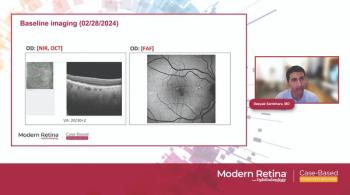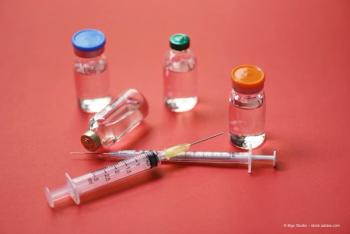
Anti-PDGF inhibitor development continues despite negative results
Despite the failure of 2 clinical trials involving a combination therapy of platelet-derived growth factor (PDGF) inhibitor and anti-vascular endothelial growth factor (anti-VEGF) therapy, a third phase III study continues.
Reviewed by Pravin U. Dugel, MD
Despite the failure of 2 clinical trials involving a combination therapy of platelet-derived growth factor (PDGF) inhibitor and anti-vascular endothelial growth factor (anti-VEGF) therapy, a third phase III study continues.
Two phase III clinical trials designed to investigate the superiority of combination therapy with PDGF inhibitor E10030 (Fovista, Ophthotech) plus ranibizumab (Lucentis, Genentech) for improving visual acuity in eyes with neovascular age-related macular degeneration (nAMD) reportedly failed to meet their primary endpoint at 1 year.
The studies, which had a planned duration of 2 years, were terminated. However, a third phase III study investigating the potential benefit of adding the PDGF inhibitor to other anti-VEGF agents is ongoing, said Pravin U. Dugel, MD.
Dr. Dugel reviewed the rationale for the combination regimen as treatment for nAMD and topline results from preclinical and clinical trials. Dr. Dugel is managing partner, Retinal Consultants of Arizona, Phoenix, and clinical professor of ophthalmology, USC Roski Eye Institute, Keck School of Medicine, University of Southern California, Los Angeles.
“There is no doubt that anti-VEGF monotherapy has revolutionized treatment for nAMD, but there is also no doubt that it has significant limitations,” Dr. Dugel outlined. “About 75% of patients do not achieve significant improvement in vision, about 50% do not achieve driving vision of 20/40 or better, and after 2 years of treatment, about 25% of patients continue to lose vision.
“The biggest limitation, however, is the disconnect between visual acuity outcomes in clinical trials and those achieved in real-world practice,” said Dr. Dugel. “Simultaneous inhibition of VEGF and alternative pathways causing pathologic angiogenesis is a logical strategy for overcoming the limitations of anti-VEGF therapy and is the rationale for investigating the role of dual inhibition of PDGF and VEGF-A.”
Promising initial results
Results from initial preclinical studies investigating simultaneous PDGF/VEGF-A blockade were positive and led to the design of a proof-of-concept phase I study investigating combination treatment with E10030 plus ranibizumab.
The results were encouraging with analyses of ETDRS best corrected visual acuity (BCVA) data showing a mean improvement from baseline to week 12 of 14 letters and almost 60% of patients gaining ≥15 letters. Retinal thickness and choroidal neovascular lesion size were also reduced.
“These positive results were achieved even though the phase I study, like other phase I trials, enrolled patients with the most severe disease,” Dr. Dugel observed.
A multicenter, double-masked phase IIb study randomized 449 patients to 1 of 3 arms to receive E10030 0.3 mg plus ranibizumab 0.5 mg; E100030 1.5 mg plus ranibizumab 0.5 mg; or ranibizumab 0.5 mg alone at monthly intervals. The study had a duration of 24 weeks, and the 3 treatment groups were well-balanced at baseline.
“This is the largest phase IIb study investigating treatment for nAMD ever conducted,” Dr. Dugel said.
The results showed that patients treated with E10030 1.5 mg plus ranibizumab had a 62% greater improvement from baseline ETDRS BCVA compared with controls receiving ranibizumab as monotherapy.
“The benefit of the combination treatment persisted in all pre-specified analyses that considered subgroups defined by baseline lesion size, central subfield thickness, and BCVA,” Dr. Dugel said.
Phase III program
The phase III program comprised 3 randomized, controlled clinical trials-the 2 terminated trials investigating E10030 1.5 mg combined with ranibizumab and the third ongoing study that is comparing E10030 1.5 mg plus bevacizumab (Avastin, Genentech) or aflibercept (Eylea, Regeneron) versus the anti-VEGF agents alone.
In the ranibizumab trials, patients were to receive monthly injections of their assigned treatments for 1 year. Thereafter, treatment was to be switched to as needed administration in 1 trial and to bimonthly in the other.
The treatment groups were well-balanced in the ranibizumab trials. Mean change in ETDRS BCVA from baseline to month 12 in the combination and ranibizumab monotherapy groups was 10.74 letters and 9.82 letters, respectively, in one trial and 9.91 letters and 10.36 letters, respectively, in the second study.
“Neither of the differences between treatment groups was statistically significant,” Dr. Dugel explained. “In addition, no benefit of combination treatment was observed in any subgroup analysis that considered baseline visual acuity, lesion size, or percentage of classic lesion. There were also no statistically significant differences between groups in secondary endpoint analyses that analyzed proportion of eyes with a ≥20-letter gain in BCVA, ≤5-letter loss in BCVA, BCVA 20/25 or better, and growth of the neovascular membrane.”
He added that if the primary endpoint is not met, an analysis of secondary endpoints is not appropriate and is not interpretable.
The combination regimen had a favorable safety profile over the 1 year of administration. There was a slightly higher incidence of injection-related adverse events in the combination arms compared with the ranibizumab monotherapy control groups, which likely was related to the fact that patients were receiving 2 monthly injections rather than 1, Dr. Dugel said.
There was no imbalance between groups in systemic adverse events.
Pravin U. Dugel, MD
This article was adapted from a presentation that Dr. Dugel delivered at the 2017 Retina World Congress. Dr. Dugel is a consultant to Ophthotech, Genentech, Roche, Alcon Laboratories, and Novartis.
Newsletter
Keep your retina practice on the forefront—subscribe for expert analysis and emerging trends in retinal disease management.








































